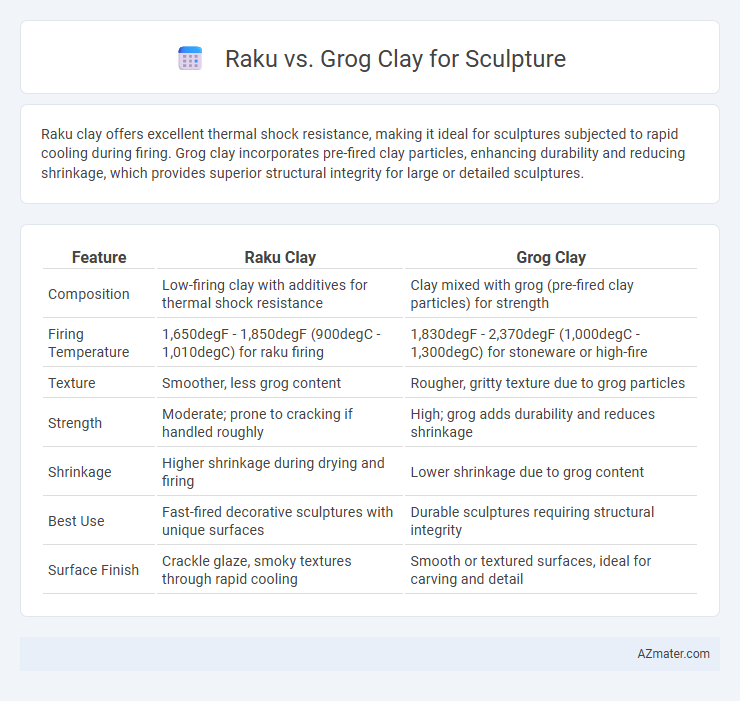Raku clay offers excellent thermal shock resistance, making it ideal for sculptures subjected to rapid cooling during firing. Grog clay incorporates pre-fired clay particles, enhancing durability and reducing shrinkage, which provides superior structural integrity for large or detailed sculptures.
Table of Comparison
| Feature | Raku Clay | Grog Clay |
|---|---|---|
| Composition | Low-firing clay with additives for thermal shock resistance | Clay mixed with grog (pre-fired clay particles) for strength |
| Firing Temperature | 1,650degF - 1,850degF (900degC - 1,010degC) for raku firing | 1,830degF - 2,370degF (1,000degC - 1,300degC) for stoneware or high-fire |
| Texture | Smoother, less grog content | Rougher, gritty texture due to grog particles |
| Strength | Moderate; prone to cracking if handled roughly | High; grog adds durability and reduces shrinkage |
| Shrinkage | Higher shrinkage during drying and firing | Lower shrinkage due to grog content |
| Best Use | Fast-fired decorative sculptures with unique surfaces | Durable sculptures requiring structural integrity |
| Surface Finish | Crackle glaze, smoky textures through rapid cooling | Smooth or textured surfaces, ideal for carving and detail |
Introduction to Raku and Grog Clay
Raku is a traditional Japanese pottery firing technique known for its rapid heating and cooling process, which creates unique crackles and metallic finishes on ceramic surfaces. Grog clay, containing pre-fired ceramic particles called grog, enhances the clay's strength, reduces shrinkage, and improves thermal shock resistance during firing. Combining Raku with grog clay results in durable sculptures that withstand the intense thermal stress of the Raku firing process while showcasing intricate surface textures.
Composition and Properties Comparison
Raku clay is formulated with grog and organic materials that create a porous structure, which enhances heat resistance and reduces thermal shock during rapid cooling in raku firing. Grog clay contains a higher percentage of ground fired clay particles, increasing the strength, durability, and texture retention, making it ideal for sculptural work that demands structural integrity. The composition differences influence firing behavior: raku clay withstands the quick temperature changes and atmospheric variations of raku firing better, while grog clay provides robust mechanical stability for detailed, large-scale sculptures.
Workability: Sculpting Ease and Tactile Feedback
Raku clay offers high workability with a smooth texture that allows for detailed sculpting and fine surface finishes, ideal for artists seeking precision. Grog clay contains grog particles that improve structural strength and reduce shrinkage, providing excellent tactile feedback and enhanced grip, which aids in forming robust, textured sculptures. While Raku clay is preferred for delicate, intricate work, Grog clay excels in durability and handling during complex modeling processes.
Firing Temperatures and Techniques
Raku clay typically fires at lower temperatures around 1,650degF to 1,850degF (900degC to 1,010degC), allowing rapid cooling and reduction firing that creates unique crackle patterns and smoky effects. Grog clay contains pre-fired clay particles, enhancing thermal shock resistance and allowing higher firing temperatures up to 2,183degF (1,195degC), ideal for durable, sculptural pieces with minimal warping. The rapid cooling in Raku contrasts with Grog's ability to withstand high-temperature firings, making choice of clay essential depending on desired surface texture and structural integrity in sculpture.
Texture and Surface Finishes
Raku clay offers a porous texture that enhances the dramatic crackling effect during rapid cooling, resulting in unique, rustic surface finishes ideal for organic, tactile sculptures. Grog clay contains pre-fired inclusions that increase surface roughness and strength, providing a more robust texture and matte finish suitable for detailed, durable works. Both clays influence the final tactile quality, with Raku emphasizing unpredictability in surface patterns and Grog enhancing controlled texture and structural integrity.
Durability and Strength in Finished Pieces
Raku pottery, characterized by its rapid cooling process, often results in a porous and fragile surface, making the finished pieces less durable and susceptible to chipping or cracking under stress. Grog clay, infused with pre-fired, ground clay particles, significantly enhances the strength and structural integrity of sculptures by reducing shrinkage and improving resistance to thermal shock. Sculptors aiming for longevity and robustness in their finished work typically prefer grog clay for its superior durability compared to traditional Raku-fired pieces.
Suitable Sculpture Applications
Raku clay, known for its porous texture and thermal shock resistance, excels in creating delicate, thin-walled sculptures and detailed surface textures that benefit from rapid cooling processes. Grog clay, enriched with granular particles, offers enhanced strength and durability, making it ideal for larger, more robust sculptures that require structural stability and reduced shrinkage during firing. Artists often choose Raku for expressive, decorative pieces with crackle effects, while Grog clay suits functional, heavy-duty sculptures needing resilience and support.
Glaze Compatibility and Effects
Raku clay offers excellent glaze compatibility due to its porous nature, allowing for rapid cooling and dramatic glaze effects such as crackling and metallic finishes. Grog clay, enriched with granular grog, enhances thermal shock resistance but can limit glaze adherence, producing more textured and matte surfaces. Sculptors seeking vibrant, unpredictable glaze patterns favor Raku, while those prioritizing durability and subtle glaze interaction often choose Grog clay.
Cost and Availability
Raku clay typically offers moderate pricing and is widely available in art supply stores and online, making it accessible for both beginners and professionals. Grog clay, enriched with granular grog, tends to be more expensive due to its enhanced durability and is often found in specialty pottery supply shops or custom orders. The choice between Raku and Grog clay depends largely on budget considerations and the specific structural requirements of the sculpture.
Choosing the Right Clay for Your Sculpture Project
Choosing the right clay for your sculpture project involves understanding the distinct properties of Raku and grog clay. Raku clay is porous and thermal shock-resistant, ideal for ceramics fired at lower temperatures with rapid cooling, making it perfect for artistic raku firing techniques. Grog clay, containing pre-fired granular particles, offers increased strength and reduced shrinkage, providing durability for large, detailed sculptures requiring high firing temperatures.

Infographic: Raku vs Grog Clay for Sculpture
 azmater.com
azmater.com